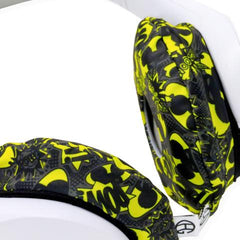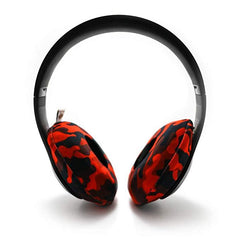Are Bone Conduction Headphones Safe?
Yes.
Bone conduction headphones are safe to wear. The technology has been used by audiologists in the development of hearing aid devices since the 1970s. The military has been using it for decades, too. Bone conduction is simply hearing sound through vibrations in the jawbone and skull. We hear things this way quite naturally. Bone conduction headphones may be considered unsafe if you were to listen through them at high volumes, but this is also true of regular headphones and earbuds. Prolonged listening through personal devices at unsafe volumes can cause permanent hearing loss regardless of how that sound is delivered to the cochlea.
How Do Bone Conduction Headphones Work?
We hear sound in two ways: through air conduction and through bone conduction.
Air conduction is how we hear most of the time. Our eardrums convert soundwaves into vibrations sending them to the cochlear — hence AIR conduction. Bone conduction, on the other hand, is when those soundwaves travel through bones in our jaw and skull. They end up in exactly the same place — the cochlear — but bypass the eardrum entirely. Bone conduction headphones rest against a person’s cheekbones rather than sitting in or on the ear as with regular headphones.
Do Bone Conducting Headphones Really Work?
Yes. They’ve been used in the development of hearing aid devices for decades. They’ve been used by the military in the United States and around the world. One of the reasons why they’re useful in both of these scenarios is that they don’t block ambient sound. For example, if someone was talking to you at a party and you were wearing a bone conducting hearing aid, then you’d be able to listen to what the person was saying whilst still being able to hear the noise of the party. In a defence setting, it’s very useful: communication is then possible between operatives who can simultaneously listen via their hearing device whilst remaining aware of their immediate environment.
Bone conduction headphones are popular with road cyclists for that same reason. It enables them to listen to phone conversations or music as they ride but keeps their ears free and alert for approaching dangers or potential hazards. Imagine how dangerous it can be if they’re wearing earphones or earbuds and riding in a busy urban environment.
Bone conductors could also work for female runners who may feel vulnerable exercising on their route.
What Do They Sound Like?
Writing on the subject of bone conduction headphones for the Sound Guys website Lily Katz writes that if you’re after sound quality then you should avoid them.
Ouch.
And she’s not the only person to say that. If you know an audiophile who flips their shit over the sound quality of wireless headphones, then they’ll be apoplectic about how bone-conducting headphones sound. The truth is that if you’re listening to music the sound quality isn’t going to be great. The real application of this technology is for anyone who is hearing impaired or for those exercising or on operations outside.
Are Bone Conducting Headphones Safe for Your Ears?
People ask if bone-conduction headphones are safe because they think the technology sounds a little scary or a bit dangerous. It isn’t. What is dangerous is listening to music at high volumes. In 2018, the World Health Organisation (WHO) listed ‘leisure noise’ as a danger to human health. Leisure noise includes listening to music through personal devices. UK news website, The Metro, accused the WHO of being the ‘fun police’ but it’s hard not to see their point when around 1 billion teenagers and young adults are at risk of hearing loss.
Bone conduction has at least as much risk as air conduction for hearing loss. This is because it’s not the eardrum that’s damaged through the high volume but the cochlear — where all soundwaves end up regardless of whether they came through air or bone.
As bone-conducting headphones are poor sound isolators, you could even be at a greater risk of hearing loss as people tend to turn up the volume when ambient sounds start bleeding through. Regular headphones — even the really cheap ones — all offer some measure of protection against this.
If you’re convinced that bone conduction sounds scarier than it is, then you might want to take a look at our post on Halo Neuroscience’s neuropriming headphones which also has its fair share of Hollywood Frankenstein terminology.
Can You Wear Bone Conduction Headphones During Exercise
There’s no reason why you can’t wear these headphones in the gym or during exercise.
The biggest advantage seems to be that the lack of noise isolation allows a person to still be aware of their surroundings — hugely important if you’re cycling or running outdoors especially in urban areas. We’ve always been big proponents of wearing on-ear or over-ear headphones (and we still are) but there are times when using closed-back or noise-cancelling headphones can be dangerous. How many of us are willing to sacrifice sound quality for better situational awareness, however, remains to be seen.
Bone conducting technology could provide a more comfortable workout. Working out in big headphones causes some people to feel a pinch or clamp against their ears and head. We wrote recently about how to make Beats headphones more comfortable after a number of people said they were struggling to find a good fit for the Solo3 Wireless in particular. Bone conductors could offer an alternative way of wearing the tech we listen to. This could equally be true for anyone struggling to wear in-earphones or earbuds in the gym.
What are Bone Conducting Sunglasses?
The technology works on the same principle as the headphones. You put on a pair of sunglasses and the arms rest on your cheekbones. Vibrations are then passed through your jaw and skull to the cochlea. One of the biggest names in the bone-conducting sunglasses market is Voxos. They provide hands-free track skipping and 10 hours of battery life with prescription, anti-UV, polarized lenses.
Integrating two popular accessories: sunglasses and headphones makes sense for those of us who exercise outside. It has to be said, too, that this could be particularly useful for the hearing impaired as traditional headphones and earbuds can interfere with hearing aids and are cumbersome to put on — particularly during a workout.
Should I Buy Bone Conduction Headphones?
Unless you’re hearing impaired or in need of open-back headphones to use when cycling or running then probably not. They’re a fantastic idea and certainly have a real-world application (and have no doubt been a God-send to those who need them) but for most people, they’re not a must-buy. The poorer sound quality for music playback will be enough to put most of us off.
And anyway, you can’t fit your EarHugz sweat-proof covers over bone-conducting headphones.
Total dealbreaker.








